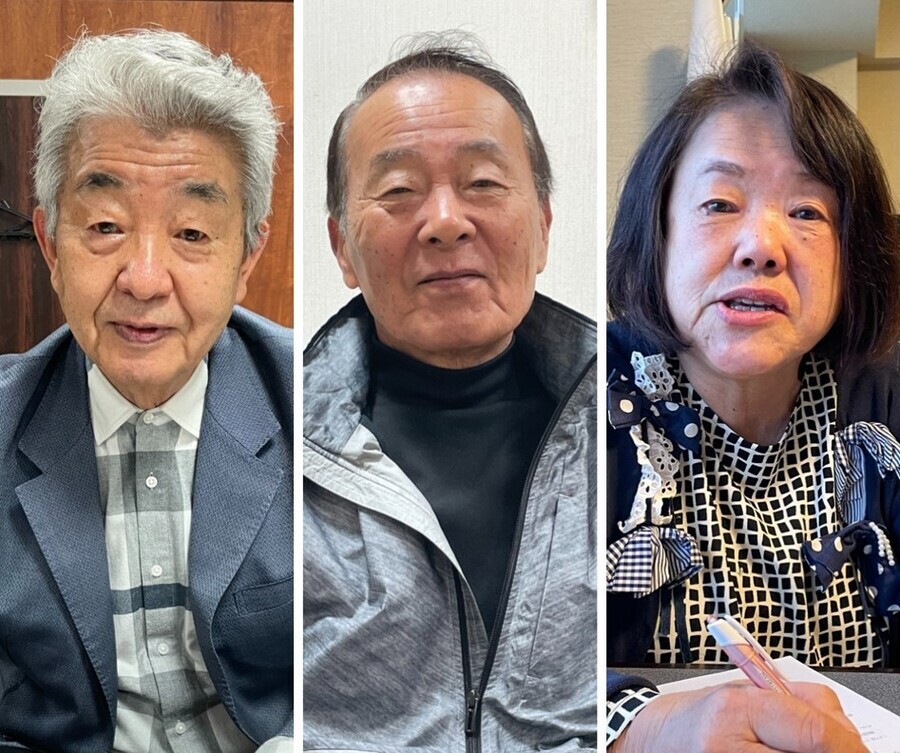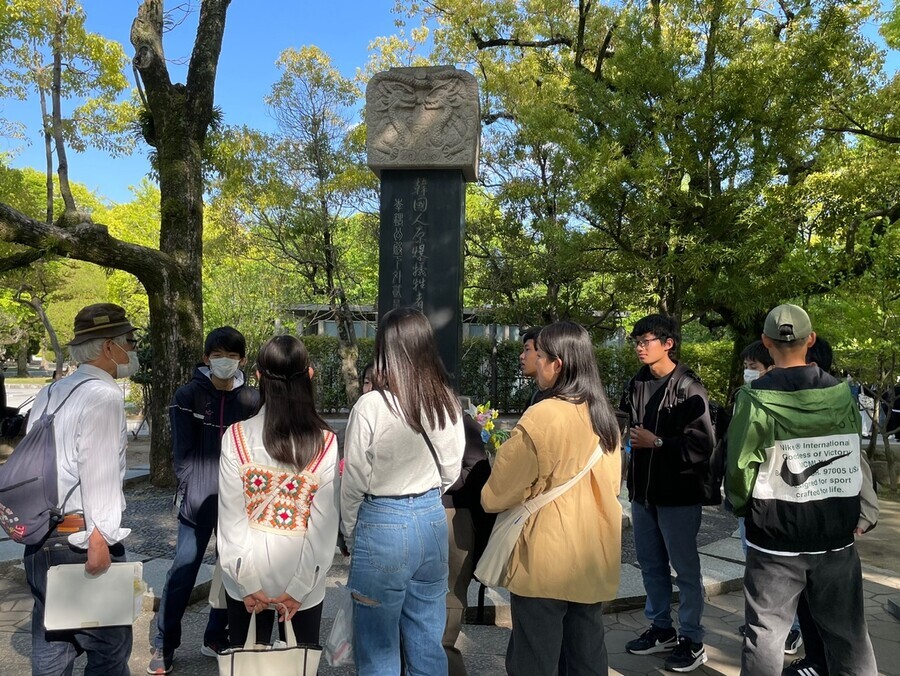hankyoreh
Links to other country sites 다른 나라 사이트 링크
As G7 leaders flock to Hiroshima, Korean A-bomb victims ask to be heard

The Hiroshima Peace Memorial Museum in the city’s center was packed to the rafters on April 26 with foreign visitors and Japanese middle and high school students on field trips.
Visitors here can see exhibits showing the horrors inflicted when the US dropped the atomic bomb “Little Boy” — the first ever used on a populated area in human history — nearly 78 years ago at 8:15 am on Aug. 6, 1945. As I followed the other visitors around, my heart felt heavy.
Hiroshima, the city that has shown the horrific violence humankind has inflicted with atomic weapons, is now drawing global attention once again as the host city for the Group of Seven summit scheduled to take place on May 19–21.
Hiroshima is also the city where Prime Minister Fumio Kishida’s home district lies. The Japanese government is working to organize trips to the museum and meetings with atomic bomb survivors for the visiting G7 leaders.
Seven years ago, in May 2016, US President Barack Obama visited the memorial to deliver a speech, after which he had a brief informal meeting with survivors. If current President Joe Biden sets up a separate occasion to speak with survivors, it would effectively be the first-ever official meeting between those survivors and the president of the country responsible for dropping the bomb.
But the victims of the atomic bomb dropped on Hiroshima were not only Japanese. Amid my conflicted emotions as I looked around the same museum the G7 leaders would be visiting, my eyes stopped on an exhibit bearing the title “Away from Home.”
I looked down the explanation underneath a painting entitled “Korean Woman with Leg Injury.”
It read, “The atomic bomb destroyed lives without regard to national or ethnic origins. Tens of thousands of Koreans, Chinese, and Taiwanese, as well as Japanese-Americans were living in Hiroshima at the time, including those who had been conscripted or recruited from these areas.”

The exhibition just next to it showed a photograph of the late Korean Association of Atomic Bomb Victims honorary chairperson Kwak Kwi-hoon, along with a brief explanation about his experience suffering the effects of the atomic bomb.
“As conscription was implemented in Korea, Kwak Kwi-Hoon (then, 21), a Korean student at Jeonju Normal School was assigned to a unit in Hiroshima in September 1944. Kwi-Hoon was bombed at roughly 2,000 m from the hypocenter while on duty. He sustained severe burns and injuries to his head and back,” it read.
While living in Korea, Kwak insisted that the Japanese government should continue to pay atomic bomb benefits even to survivors who had relocated to a different country than Japan.
“A-bomb survivors know no borders,” he said. He fought — and ultimately won — an intense legal battle to earn benefits.
This exhibition stressing that Japanese people were not the only ones victimized by the atomic bomb was added when the museum was renovated in April 2019. It certainly is a step forward, but it also omits any explanation of why so many Koreans were in Hiroshima when the bomb was dropped. I could see no sign of reflecting on or confronting the historical facts of Japan’s colonization of Korea and aggressions elsewhere in Asia.
Members of the first generation of atomic bomb victims have made no secret of their conflict feelings as they have grappled with this reality in Japan.
“Why were Koreans forced into a position where they became victims of the atomic bombs dropped by the US military in Japan?” asked Kim Jin-ho, the 78-year-old executive director of the Hiroshima Prefecture Association for Korean Atomic Bomb Survivors.
“This tragic outcome would never have happened if Korea had not been a Japanese colony,” he stressed.
“Yet neither Japan nor the US has apologized to Koreans for the damage caused by the atomic bombs, and there is no content about that in the museum’s exhibitions,” he continued.

Kim went on to say that the ruling in Kwak Kwi-hoon’s favor described in the exhibit has not been fully complied with. The reason, he explained, has to do with Japan still having no diplomatic relations with North Korea.
“Atomic bomb survivors in North Korea have not received any support to date because there are no diplomatic relations [between North Korea and Japan],” he said, calling this a “violation of human rights.”
The Korean Peninsula is home to the second-largest number of atomic bomb survivors in the world, after Japan. Of the 80,000 Koreans who were living in Hiroshima when it was bombed in August 1945, around 50,000 were directly affected. An estimated 30,000 of them died in the bombing.
But with the precise scale of the impact unknown, the matter remains the subject of continued debate. The loss of historical records means there is no way of determining the full picture.
The city of Hiroshima estimates that around 140,000 Japanese people were victimized by the atomic bomb dropped on the city, while 5,000 to 8,000 of those killed were from the Korean Peninsula. During his visit in 2016, Obama spoke of the “thousands” of Korean victims. For atomic bomb survivors from the Korean Peninsula, his words were seen as deeply wounding.
The Koreans who remained behind in Hiroshima rather than returning home after liberation have had to battle bitterly over the years with three sources of suffering: discrimination against Koreans, the stigma of being atomic bomb survivors, and dire poverty. Many victims have also suffered due to health conditions that may be the result of radiation exposure.
Kwon Jun-o, the 73-year-old vice chairperson of a special committee for atomic bomb victims in the Hiroshima office of the Korean Residents Union in Japan (Mindan), is one of the second-generation survivors.
“We must never forget that tens of thousands of atomic bomb victims were Koreans who had nothing at all to do with the war started by Japan,” he stressed, adding that he wanted to “communicate this fact with the G7 leaders.”
But Kwon bitterly predicted that the South Korean victims would “not get the chance.”
“For Japan, the atomic bomb survivors from the Korean Peninsula show its dual nature as both victim and aggressor. The Japanese government isn’t going to make them a part [of the summit meeting on May 19],” he said.
It’s a situation that he has learned from past experience. When Obama visited Hiroshima, Kwon requested several times for him to meet with Korean survivors in addition to Japanese ones, but this never came about.

Also invited to the G7 summit this month is South Korean President Yoon Suk-yeol. It is to be the first-ever visit to Hiroshima by a South Korean president.
With Yoon having already shared plans involving unilateral concessions to Japan on the compensation of forced labor mobilization survivors — which had been the core bone of contention in the two sides’ relationship — the omission of the Korean atomic bomb survivor issue at the G7 summit could end up pouring cold water on the climate of improving relations.
The people I spoke to in Hiroshima stressed that Yoon would need to communicate with Kishida about the Korean atomic bomb survivor issue during a South Korea-Japan summit scheduled to take place in Seoul early next week.
“It makes total sense that the G7 leaders should meet with victims from the Korean Peninsula in order to understand about the horrors of atomic weapons,” said Etsuko Nakatani, a 73-year-old supporter of Korean atomic bomb victims who heads the Hiroshima branch of the Citizens’ Association for the Relief of A-bomb Victims in South Korea.
“They must not be treated like they don’t exist,” she stressed.
In addition, she called on the South Korean and Japanese leaders to meet in Hiroshima to discuss the atomic bomb survivor issue.
“To ensure this sort of history does not repeat itself, there needs to be a direct apology from Japan,” she insisted. “It is also urgently necessary for South Korea and Japan to work together to properly understand the true situation of atomic bomb victims from the Korean Peninsula.”
By Kim So-youn, Tokyo correspondent
Please direct questions or comments to [english@hani.co.kr]

Editorial・opinion
![[Column] Season 2 of special prosecutor probe may be coming to Korea soon [Column] Season 2 of special prosecutor probe may be coming to Korea soon](https://flexible.img.hani.co.kr/flexible/normal/500/300/imgdb/original/2024/0426/3317141030699447.jpg) [Column] Season 2 of special prosecutor probe may be coming to Korea soon
[Column] Season 2 of special prosecutor probe may be coming to Korea soon![[Column] Park Geun-hye déjà vu in Yoon Suk-yeol [Column] Park Geun-hye déjà vu in Yoon Suk-yeol](https://flexible.img.hani.co.kr/flexible/normal/500/300/imgdb/original/2024/0424/651713945113788.jpg) [Column] Park Geun-hye déjà vu in Yoon Suk-yeol
[Column] Park Geun-hye déjà vu in Yoon Suk-yeol- [Editorial] New weight of N. Korea’s nuclear threats makes dialogue all the more urgent
- [Guest essay] The real reason Korea’s new right wants to dub Rhee a founding father
- [Column] ‘Choson’: Is it time we start referring to N. Korea in its own terms?
- [Editorial] Japan’s rewriting of history with Korea has gone too far
- [Column] The president’s questionable capacity for dialogue
- [Column] Are chaebol firms just pizza pies for families to divvy up as they please?
- [Column] Has Korea, too, crossed the Rubicon on China?
- [Correspondent’s column] In Japan’s alliance with US, echoes of its past alliances with UK
Most viewed articles
- 11 in 5 unwed Korean women want child-free life, study shows
- 2AI is catching up with humans at a ‘shocking’ rate
- 3[Editorial] Yoon cries wolf of political attacks amid criticism over Tokyo summit
- 4[Photo] “Comfort woman” survivor calls on president to fulfill promises
- 5“Japan’s No. 1 salesman”: Korean groups blast president’s treatment of forced laborers
- 6Yoon calls 60+ hour workweek “unreasonable,” orders revamp of policy
- 7[Editorial] Yoon’s white flag on historical disputes with Japan backfires immediately
- 8‘We must say no’: Seoul defense chief on Korean, USFK involvement in hypothetical Taiwan crisis
- 9[Special reportage- part I] Elderly prostitution at Jongmyo Park
- 10[Photo] More Sewol paintings by Hong Sung-dam